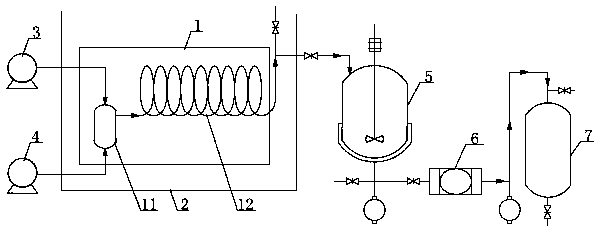Method for preparing 1,4-butane sultone by micro-channel reactor
A micro-channel reactor, sultone technology, applied in the direction of organic chemistry, etc., can solve the problems of poor temperature control effect of single-pot reaction, long mixing and contact time, easy to produce by-products, etc., to improve the molar yield and eliminate local Overheating phenomenon, molar yield improvement effect
- Summary
- Abstract
- Description
- Claims
- Application Information
AI Technical Summary
Problems solved by technology
Method used
Image
Examples
Embodiment 1
[0025] 1. At room temperature, dissolve 132.3g of sodium sulfite in 529.4g of deionized water, stir and dissolve, and prepare an aqueous solution of sodium sulfite with a mass fraction of 20%.
[0026] 2. The heater is heated to 80°C, and the sodium sulfite aqueous solution and 150.6 g of chlorobutyl acetate are respectively pumped synchronously by the first micropump 3 and the second micropump 4 to the premixer 11 for mixing, and the flow rate of the sodium sulfite aqueous solution is 14.31 mL / min, the flow rate of chlorobutyl acetate is 1.36mL / min.
[0027] The mixed material in the premixer 11 enters the microchannel module 12 and reacts. The hydraulic diameter of the microchannel in the microchannel module 12 is 1.0mm, and the length of the microchannel is 100m. The residence time of the material in the microchannel module is 300s, the molar ratio of chlorobutyl acetate to sodium sulfite is 1:1.05.
[0028] 3. The reaction solution enters the reactor 5 from the discharge...
Embodiment 2
[0031] 1. At room temperature, dissolve 132.3g of sodium sulfite in 529.4g of deionized water, stir and dissolve, and prepare an aqueous solution of sodium sulfite with a mass fraction of 20%.
[0032] 2. The heater is heated to 120°C, and the sodium sulfite aqueous solution and 150.6g of chlorobutyl acetate are respectively pumped synchronously by the first micropump 3 and the second micropump 4 to the premixer 11 for mixing, and the flow rate of the sodium sulfite aqueous solution is 14.31mL / min, the flow rate of chlorobutyl acetate is 1.36mL / min.
[0033]The mixed material in the premixer 11 enters into the microchannel module 12 and reacts. The hydraulic diameter of the microchannel in the microchannel module 12 is 1.0mm, and the length of the microchannel is 100m. The material is in the microchannel of the microchannel module. The residence time is 300s, and the molar ratio of chlorobutyl acetate to sodium sulfite is 1:1.05.
[0034] 3. The reaction solution enters the ...
Embodiment 3
[0037] 1. At room temperature, dissolve 132.3g of sodium sulfite in 529.4g of deionized water, stir and dissolve, and prepare an aqueous solution of sodium sulfite with a mass fraction of 20%.
[0038] 2. The heater is heated to 145°C, and the sodium sulfite aqueous solution and 150.6g of chlorobutyl acetate are respectively pumped synchronously by the first micropump 3 and the second micropump 4 to the premixer 11 for mixing, and the flow rate of the sodium sulfite aqueous solution is 14.31mL / min, the flow rate of chlorobutyl acetate is 1.36mL / min.
[0039] The mixed material in the pre-mixer 11 enters the microchannel module 12 for reaction, the hydraulic diameter of the microchannel in the microchannel module 12 is 1.0mm, and the length of the microchannel is 100m, and the material is in the microchannel of the microchannel module The residence time is 300s, and the molar ratio of chlorobutyl acetate to sodium sulfite is 1:1.05.
[0040] 3. The reaction solution enters th...
PUM
 Login to View More
Login to View More Abstract
Description
Claims
Application Information
 Login to View More
Login to View More - Generate Ideas
- Intellectual Property
- Life Sciences
- Materials
- Tech Scout
- Unparalleled Data Quality
- Higher Quality Content
- 60% Fewer Hallucinations
Browse by: Latest US Patents, China's latest patents, Technical Efficacy Thesaurus, Application Domain, Technology Topic, Popular Technical Reports.
© 2025 PatSnap. All rights reserved.Legal|Privacy policy|Modern Slavery Act Transparency Statement|Sitemap|About US| Contact US: help@patsnap.com


